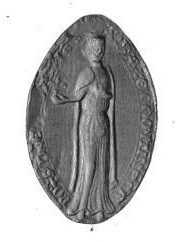Isabelle of Chartres facts for kids

Isabelle of Blois (died 1248 or 1249) was an important noblewoman in France. She was known as the lady of Amboise through her first marriage. Later, from 1218 until her death, she became the Countess of Chartres in her own right. Isabelle was also famous for starting three Cistercian monasteries for nuns. She was married twice, and after her death, her daughter, Matilda, took over her titles.
Contents
Who Was Isabelle of Blois?
Isabelle was likely born before the year 1180. She came from a very important and powerful family in France. Her father was Count Theobald V of Blois and Chartres. Her mother was Alice, who was the daughter of King Louis VII and Duchess Eleanor of Aquitaine.
Isabelle had an older brother named Louis I of Blois, who was also a count. She also had two sisters: Margaret and Alice. Alice became the head of a monastery called Fontevraud between 1209 and 1218.
Her Marriages and Children
Isabelle was married two times during her life.
Her first marriage was in 1190 to Sulpice III of Amboise. They had six children together: Hugh, Matilda, John, William, Alice, and Dionysia. Before 1209, Isabelle and Sulpice worked together to start a Cistercian monastery called the Abbey of Moncé.
When Sulpice died sometime between 1214 and 1218, their son Hugh inherited the lands of Amboise. Later, around 1237, Matilda took over from Hugh. We don't know what happened to Isabelle and Sulpice's four younger children. Isabelle gave many gifts to the Moncé monastery to honor Sulpice's memory. She even paid for a priest to say mass there every day.
In 1218, Isabelle married for the second time to John II of Montmirail. He was a lord of Montmirail and Oisy. Isabelle and John did not have any children together.
Becoming a Countess
In 1218, Isabelle's nephew, Count Theobald VI, died without any children. This meant his lands and titles needed to be divided. King Philip II decided how to split them. Isabelle's sister, Margaret, received the county of Blois. Isabelle received the county of Chartres.
Isabelle's second husband, John, paid a special fee to the king. This fee was a traditional payment made when someone inherited land. In August, the king officially confirmed that Isabelle would be the Countess of Chartres. Her cousin, Count William II of Perche, helped make sure everything was in order. In July 1221, William gave Isabelle and her future heirs some land at Montigny-le-Chartif.
Founding Monasteries and Helping Others
Isabelle was very religious and used her wealth to help others.
In 1222, Isabelle and John started a Cistercian nunnery. It was called the Abbey of Lieu-Notre-Dame-lès-Romorantin. This monastery was built on her land in Romorantin. It was located near a marshy area called the Sologne. The nuns were given 36 arpents (a unit of land) to clear and farm. In 1232, Isabelle's daughter Matilda and her husband, Richard II of Beamont, gave the nuns another 100 arpents. They could use this land for free if they farmed it.
In 1226, Isabelle and John founded another Cistercian nunnery. It was called the Abbey of Notre-Dame de l'Eau. They bought the land for this monastery from Lady Adeline of Ver. The bishop of Chartres and the abbot of Saint-Père-en-Vallée helped them.
Many of Isabelle's official documents for Lieu monastery are still preserved today. They are in a collection called a cartulary from 1269 or 1270. Sadly, many documents for Eau monastery were lost in a fire in the 1500s. Today, we have 92 of her documents for Lieu and 35 for Eau.
Besides starting her own monasteries, Isabelle also gave generously to other religious houses that her family supported. She gave money or confirmed gifts to places like Saint-Antoine-des-Champs, Notre-Dame-la-Trappe, Notre-Dame de Barbeau, Vaucelles Abbey, Notre-Dame-des-Clairets, and La Madeleine de Châteaudun. She also supported an almshouse (a place for the poor) in Châteaudun and a leprosarium (a place for people with leprosy) called Grand-Beaulieu.
In 1226, William of Perche died. He left Isabelle his share of the money from the mills of Chartres to "support the poor." Isabelle gave this money to the nuns at Eau.
Isabelle's second husband died in 1238 or 1239. To honor him, she gave 435 livres tournois (a type of French money) to help the poor.
Later Life and Legacy
In 1241, Isabelle's niece, Countess Mary of Blois, died. Mary left all her property, including the county of Blois, to her husband, Count Hugh, and to Isabelle. Hugh kept control of the county.
In 1247, Isabelle wrote her will. In it, she confirmed all the gifts she had made to Lieu monastery. She also set up a special chapel there. Masses were to be said daily for her, her family, and her cousin, Queen Blanche. In 1248, she bought back some land at Saugirard. Her brother had given this land to the abbey of Barzelle before 1205. Isabelle then gave it to the nuns of Lieu.
Isabelle died in 1248 or 1249. Her daughter Matilda, who was a widow, became her successor.

